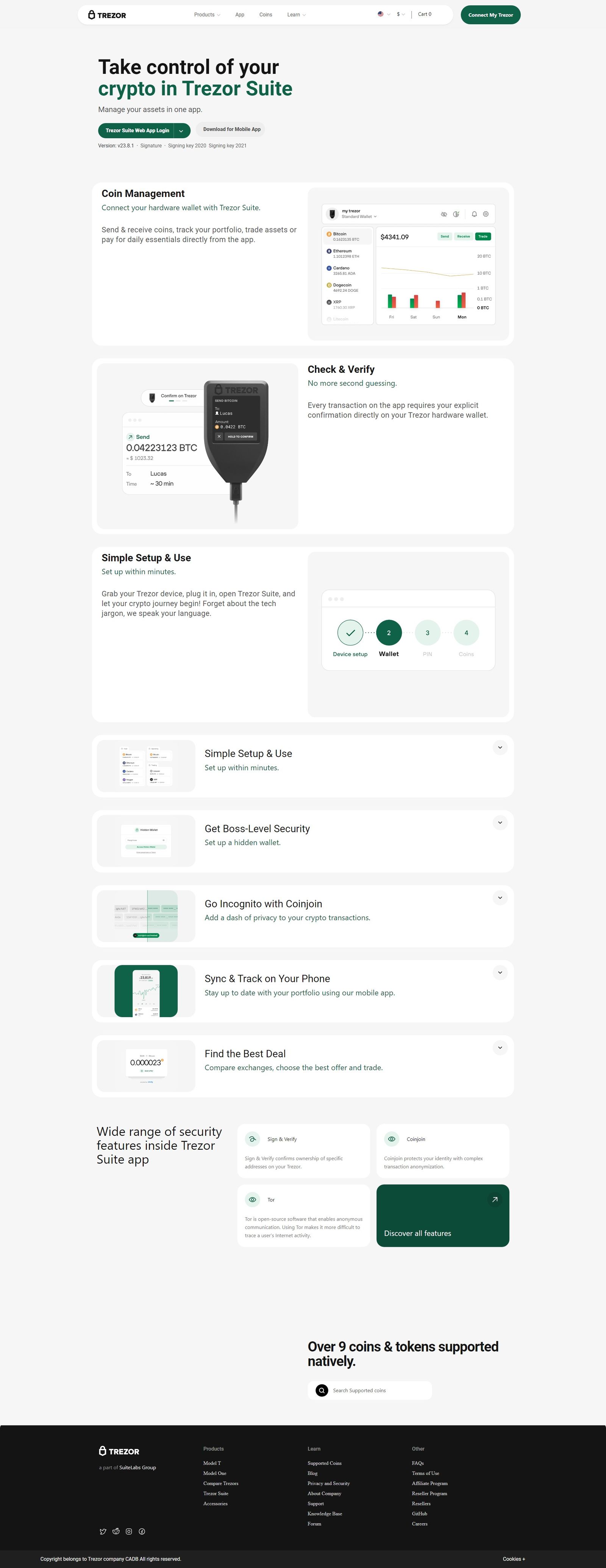
What Is “Trezor.io/Start”? 🎯
This dedicated onboarding portal is designed by Trezor to guide users from unboxing their device to full operation. The steps include:
Verifying the integrity of your hardware (packaging, seal, authenticity) Trezor+1
Installing the latest firmware on your device Trezor+1
Creating a new wallet (or recovering an existing one) Trezor+1
Backing up the wallet with your recovery seed (12, 18, or 24 words depending on model) Trezor+1
Setting a PIN / passphrase to protect the device Trezor+1
In short: this page is where you begin your secure crypto journey.
Key Features & Benefits of Following the Setup ✅
Offline Key Storage & Maximum Custody
Your private keys never leave the hardware wallet. That means they aren’t exposed to internet-connected devices where hacks or malware can strike.
Verified Firmware & Authenticity
Each device starts without firmware and prompts you to install the latest version via Trezor Suite. This ensures the device is genuine and secure. Trezor+1
Recovery Seed Backup = Crypto Insurance
The recovery seed is the lifeline to access your funds if something happens to your device. Trezor.io/start emphasizes writing it down on paper, keeping offline, never sharing. Trezor+1
Multi-Asset & Open-Source Friendly
Trezor supports Bitcoin, Ethereum, many other coins and tokens, and is built with open-source firmware so the community can audit and trust it. trezorwallet.s3.amazonaws.com+1
Enhanced Security Practices
— Checking for tampering or fake devices before setup. Trezor
— Option for passphrase protection (an extra “hidden” wallet layer) plus PIN protection.
— You’re trained from the start to type the URL manually, avoid phishing links, and trust only the official site. trezorwallet.s3.amazonaws.com
Technical Guide: How to Set It Up 🛠️
Step 1: Unbox & Inspect
– Check the package is sealed, no signs of tampering. If anything’s off, do not proceed. Trezor
Step 2: Connect to Your Computer (or Mobile)
– Use the USB cable (or on newer devices, Bluetooth/USB-C for mobile) to connect the device. Trezor+1
Step 3: Visit Trezor.io/start / Launch Trezor Suite
– Navigate manually to ensure you’re on the real URL. The page will prompt you to download the Suite or to begin setup.
Step 4: Install Firmware
– The device ships without firmware for security; the Suite will guide you to install the latest. Accept only the official update. Trezor
Step 5: Authenticate Device
– A cryptographic authenticity check ensures your hardware is genuine and untampered. Go through the prompts. Trezor
Step 6: Create New Wallet or Recover One
– If you’re new: choose “Create new wallet”.
– If you already have a seed from a previous wallet: choose “Recover wallet”. Trezor+1
Step 7: Backup Your Recovery Seed
– Write down the words (don’t take a photo or store digitally!).
– Verify you’ve written them correctly when prompted. Trezor
Step 8: Set a PIN & Optional Passphrase
– Choose a strong PIN. Activate additional passphrase protection if you want a hidden wallet layer.
Step 9: Activate Coins & Use
– Select which cryptocurrencies you’ll manage, and you’re good to go! The wallet is ready to receive/send funds securely. Trezor
Frequently Asked Questions (FAQs) 🤔
Q1. Is “Trezor.io/start” safe to use?
Yes. This is the official onboarding page created by Trezor. Always verify the URL yourself and don’t click links from unsolicited emails.
Q2. What happens if I lose my recovery seed?
Without your seed, you cannot recover your wallet if your device is lost or damaged. It’s the only backup of your funds.
Q3. Can I skip visiting “Trezor.io/start”?
No — skipping means you may miss installing official firmware or verifying your device, which risks security.
Q4. Do I need to use Trezor Suite?
It’s strongly recommended. While third-party wallets may support your device, the Suite provides full integration, firmware updates, and authentication features.
Conclusion: Why This Matters 🏁
In the world of cryptocurrency, you are the custodian of your funds. No bank, no vault, no intermediary — just you and your keys. That’s why doing the setup right via Trezor.io/start matters. From verifying hardware authenticity to backing up your wallet and setting a PIN, each step builds a fortress around your digital assets.
Trezor.io/start – Secure Your Trezor Device